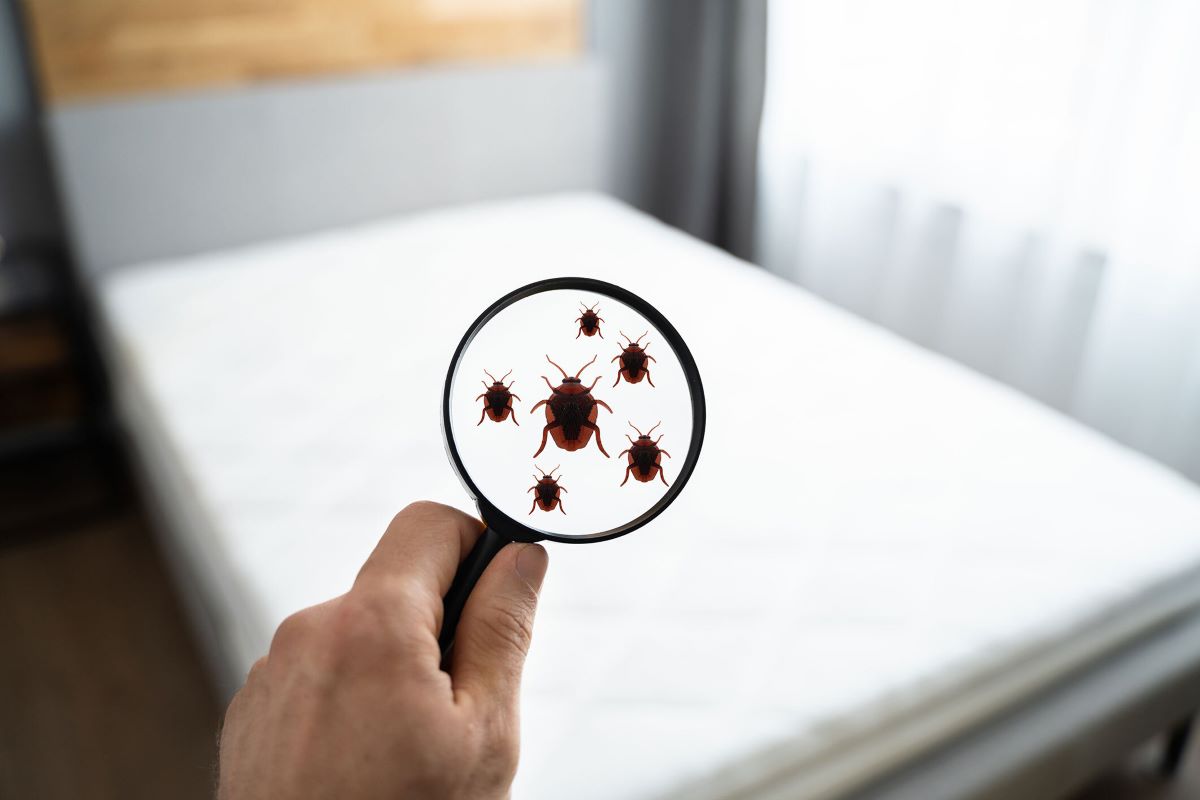Find out whether the bedbugs are in your house or the hotel room they are staying in if you don’t want to get bitten by them. Learn how to identify live bed bugs and the indications that indicate an infestation of bed bugs in your home.
The next step is to search for bed bugs, faeces, and blood stains in places where bed bugs are known to hide, such as beds and sofas. If you need help locating any indications of bed bugs, you should explore locations that are less likely to conceal them, and that may be difficult for you to reach. Let’s know how to check for bed bugs in detail.
Quick Access
How To Check If Your Bed Has Bed Bugs?
Bed bugs are small, reddish-brown insects that forage on human blood. They can be difficult to detect, as they are nocturnal and typically hide in cracks and crevices during the day. If you suspect you may have bed bugs in your bed, it’s important to confirm their presence and take action to eliminate them.
Here are some tips on how to check for bed bugs in your bed:
- Inspect the bedbug seams and folds of your mattress and box spring for small, reddish-brown bugs or tiny white eggs. These insects are about the size of an apple seed and are usually found in clusters.
- Check your bed frame, headboard, and footboard for bugs, eggs, and any cracks or crevices where they may be hiding. Be sure to check the undersides of these items as well.
- Look for small blood spots on your sheets or mattress, which may be a sign of bed bugs that have been squashed. These insects can also leave faecal matter and shed skins behind, which can be another sign of their presence.
- Use a flashlight to inspect the area around your bed, including the baseboards and nearby furniture, for any signs of bed bugs. These insects can also hide in electrical outlets and switch plates, so be sure to check these areas as well.
- Place bed bug interceptors under the legs of your bed to trap any bugs that may be trying to climb up into the bed. These small, shallow cups have a sticky surface that bed bugs will get stuck on when climbing up the bed.
If you suspect you have bed bugs, it’s important to contact a professional pest control company for treatment. Do not try to get rid of bed bugs, as this can cause them to spread to other areas of your home.
Can You See Bed Bugs?
Bed bugs can be difficult to see as they are nocturnal and typically hide in cracks and crevices during the day. However, it is possible to see bed bugs if you know where and what to look.
Adult bed bugs are roughly the size of an apple seed and are generally reddish-brown. Bed bugs can be found in clusters, usually in the seams and folds of your mattress and box spring, as well as in the cracks and crevices of your bed frame, headboard, and footboard.
Bed bug nymphs, immature bed bugs, are smaller and more translucent in colour than adult bed bugs. They can be found in the same areas as adult bed bugs. Bed bug eggs are small and white, and they are usually found in the seams and folds of your mattress and box spring, as well as in the cracks and crevices of your bed frame, headboard, and footboard.
It’s also important to note that bed bugs can hide in other areas of your home, such as in the baseboards, electrical outlets, and switch plates, so it’s important to inspect these areas.
How To Get Rid Of Bed Bugs?
Getting rid of bed bugs can be challenging, but it is possible with the right approach. Here are some steps you can take to eliminate bed bugs from your home:
Contact a professional pest control company.
Bed bugs are difficult to eliminate and often require specialized pesticides and equipment. A professional pest control company can provide an effective treatment that targets all life stages of bed bugs.
Prepare your home for treatment.
Before the pest control company arrives, it’s important to prepare your home by removing clutter, vacuuming all surfaces, and washing all bedding and clothing in hot water. This will help to remove any bugs and eggs that may be hiding in these areas.
Use heat treatment together with insecticides.
Pesticides alone may not be enough to eliminate all bed bugs, so it’s important to use a combination of treatments. Heat treatment is a particularly effective method, as it can kill all life stages of the bed bug, including eggs.
Follow up with ongoing inspections and treatments.
Bed bugs can be hardy and persistent, so monitoring your home for any signs of an infestation is important. A professional pest control company can provide ongoing inspections and treatments to eliminate bed bugs.
Seal cracks and crevices
Seal up any cracks and crevices around your home, especially around baseboards and electrical outlets, to prevent bed bugs from returning to your home.
Use bed bug-proof encasements and interceptors
Use bed bug-proof encasements for your mattress and box spring to prevent bed bugs from hiding in your bed. Also, place bed bug interceptors under the legs of your bed to trap any bugs trying to climb into your bed.
Keep your bedding and clothes clean.
Regularly clean your bedding and clothes, especially if you travel frequently. Use high heat to dry your clothes and bedding and store them in sealed containers or bags.
What Health Problems Can Occur?
Bed bugs can cause several health problems, both physically and mentally.
Allergic reactions
Some people may be allergic to bed bug bites, which can cause redness, swelling, and itching. In extreme cases, an allergic reaction can lead to anaphylaxis, a life-threatening condition needing prompt medical attention.
Skin infections
Scratching bed bug bites can lead to skin infections like impetigo, folliculitis, or cellulitis. These infections can cause redness, swelling, and pain and may require antibiotic treatment.
Anaemia
In rare cases, bed bug bites can lead to anaemia, a condition without enough red blood cells to carry oxygen throughout the body. Anaemia can induce deficiency, fatigue, and shortness of breath.
Insomnia
The knowledge of bed bugs in your bedroom can cause anxiety and stress and disrupt sleep quality. People may have difficulty sleeping and feel unable to relax, leading to insomnia.
Psychological effects
The presence of bed bugs can cause psychological distress, leading to anxiety, depression, and feelings of shame and disgust. The constant fear of being bitten can also lead to a loss of self-esteem and helplessness.
Secondary bacterial infections
Scratching the bites can cause secondary bacterial infection to the skin, leading to more severe issues. Other health issues such as Asthma and eczema can worsen due to bed bugs as they can trigger allergic reactions.
Early Signs For Bed Bugs
Bed bugs are often difficult to detect, as they are nocturnal and typically hide in cracks and crevices during the day. However, there are some early signs that you can look out for to determine if you have a bed bug infestation in your home.
Bites on the skin
One of the most common early signs of bed bugs is bites on the skin. These bites are often grouped in a line or cluster and may be itchy or swollen.
Blood spots on sheets or mattresses
Bed bugs can leave small spots on them as they feed. These spots may be reddish or rust-coloured.
Faecal matter and shed skins
Bed bugs can leave faecal matter, which appears as small, dark spots, and shed skins, which are translucent in colour, on sheets, mattresses, or nearby surfaces.
Live bugs or eggs
Look for live bed bugs or eggs, which are small and white, in the seams and folds of your mattress and box spring, as well as in the cracks and crevices of your bed frame, headboard, and footboard.
Unpleasant Odor
Bed bugs may release an unpleasant, musty odour caused by the pheromones they release to communicate with each other.
Family members’ bugs bites
If you or other household members wake up with bites or have visible bugs on their skin, this is a strong indication of bed bugs.
Conclusion
You currently have a strategy for how to check for bed bugs. Keep in mind that security comes first. Additionally, bed bugs are experts at concealing, so take your time and conduct a complete inspection. Examine bedbugs on the mattress and box springs’ seams and folds and the gaps and crevices in your bed frame, headboard, and footboard to look for bed bugs.
Look for tiny, reddish-brown insects, groups of skin bites, bloodstains on bed linens or mattresses, faeces, and skin sheds. Additionally, it’s crucial to check your home’s baseboards, electrical outlets, and switch plates. If you have bed bugs, seek treatment from a reputable pest control provider.

